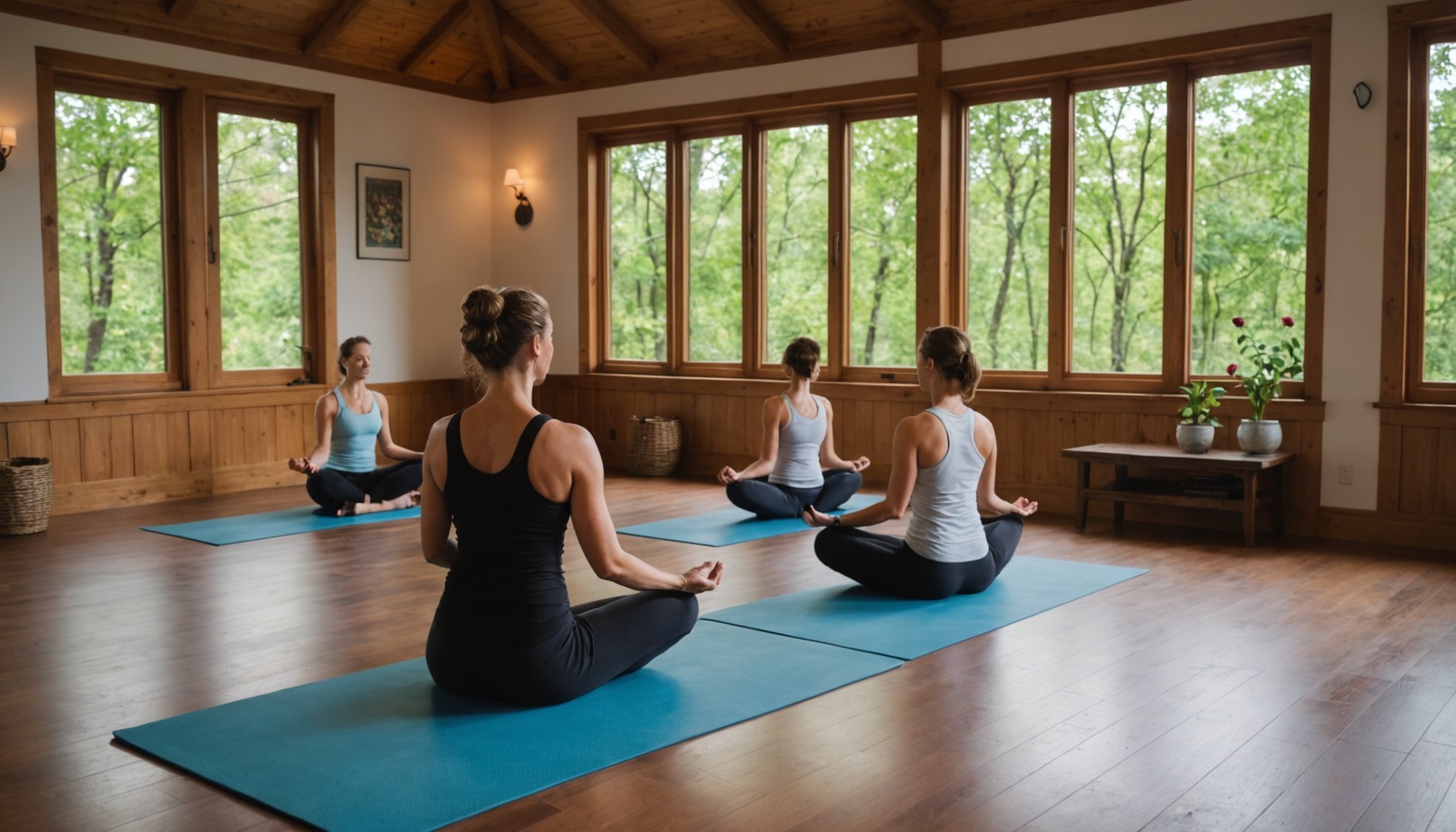Creating the Ideal Environment for Yoga
To cultivate a calming space for your yoga practice, establishing a dedicated yoga environment is essential. This goes beyond the physical setup; it’s about creating a sanctuary that encourages connection and tranquility. A key aspect of such a space is silence. The absence of noise allows for extreme focus, helping you to meditate or practice seamlessly. Cleanliness also plays a critical role. A tidy area diminishes distractions and fosters a clean slate both physically and mentally.
Comfort forms the bedrock of an effective home practice. Imagine a space adorned with soft pillows and warm rugs that beckon relaxation and ease. Take inspiration from home retreats that individuals have transformed over time. For example, Sarah transformed her garage into a serene yoga studio, perfect for her daily rituals. She’s praised the calming effect of lavender incense and neutral tones.
Also to discover : Revitalize Your Home: Unveiling the Advantages of Natural Décor Elements
Bringing life to your yoga environment involves these elements, creating a cocoon of peacefulness that echoes your personal wellness journey. By prioritising these factors, your home can reflect a perfect setting to unwind, rejuvenate, and deepen your yoga practice.
Selecting the Right Lighting
Creating the ideal yoga environment involves choosing appropriate lighting options that evoke tranquility and focus. Warm lighting is often preferred as it creates a soothing ambiance without overwhelming the senses. Natural light also plays a significant role. Positioning your yoga mat near a window can help absorb the energy of the sun, enhancing your practice. Combining this with sheer curtains allows light to filter softly into the room, maintaining a calming space.
In parallel : Transform your home décor: the benefits of embracing natural materials
For times when natural lighting isn’t an option, you can explore various artificial lighting choices. Dimmers are a fantastic addition, providing flexibility to adjust the brightness to suit different phases of your practice. Additionally, candles bring warmth and peace, perfect for creating a home retreat. They play a subtle part in setting a meditative mood where focus and relaxation can thrive.
Incorporating a mix of natural and strategic artificial lighting will optimize your surroundings, supporting yoga and meditation alike. By refining these lighting options, you can tailor your space to be a perfect haven for mindfulness, encouraging calm energy and profound focus.
Choosing Mindful Decor Elements
Creating a yoga environment that nurtures serenity and mindfulness involves more than just arranging cushions and mats. Thoughtfully selected decor ideas can transform any space into a calming sanctuary.
Colour Psychology
Colours wield the power to influence emotions. Soft blues and greens evoke calmness, while neutral tones provide a peaceful backdrop for your practice. Choosing a palette that harmonizes with your mood and intention enriches your yoga space, fostering deeper meditation and focus.
Art and Imagery
Incorporate art pieces that inspire tranquility. Opt for serene landscapes or abstract designs that invite introspection. These personal touches can act as focal points, encouraging a mindful practice by drawing your attention to the present moment.
Natural Elements
Plants infuse life and energy into your space, offering both aesthetic and health benefits. The presence of greenery enhances mindfulness by connecting with nature, acting as a gentle reminder of growth and tranquility. Select low-maintenance plants that thrive indoors to ensure a seamless integration into your yoga retreat. By embracing these decor elements, you can cultivate a peaceful and inviting yoga environment, perfectly attuned to personal wellness and mindfulness.
Furniture Arrangement for Comfort
Creating the perfect yoga environment involves carefully considering the furniture layout. Begin by selecting ergonomic seating that promotes comfort during meditation sessions. Seating arrangements like floor cushions or low stools can be ideal, ensuring that your posture remains optimum, vital for fostering a calming space.
It’s essential to optimise your space for easy movement and flow. Position furniture in a way that allows unobstructed paths, which helps to maintain focus and reduces the risk of disruptions during your practice. Multi-functional furniture can also be a game-changer, particularly in compact spaces. Consider pieces that can double as storage, like ottomans with hidden compartments, to keep your yoga environment tidy and efficient.
Another beneficial aspect is the inclusion of mobile furniture. Items such as foldable tables or chairs can offer the flexibility to transform your space as needed. These elements ensure your home retreat is adaptable, providing a supportive sanctuary for yoga that evolves with your changing needs. By focusing on furniture arrangement, you can create an inviting and functional yoga corner that enhances both comfort and tranquility.
Incorporating Sensory Elements
Adding sensory balance to your yoga environment can enrich your practice significantly. Engaging the senses helps cultivate mindfulness and deep relaxation. Let’s explore how you can achieve this.
Fragrance and Aromatherapy
Incorporating scent diffusion in your practice can transform your calming space into a sanctuary. Essential oils like lavender, eucalyptus, and chamomile promote relaxation and stress relief. Using diffusers or scented candles allows these subtle aromas to fill your space, enhancing the soothing ambiance.
Background Sounds
Creating soundscapes with calming music or nature sounds is another way to elevate your yoga practice. Background sounds can drown out distracting noises, helping you to achieve a state of focus and tranquility. Consider creating a playlist that includes gentle melodies or sounds of waves, rainfall, or birds.
Tactile Textures
Lastly, utilising tactile textures in your environment can add to the sensory richness. Soft fabrics such as plush rugs, cushions, and throws invite comfort and help ground your practice. Choose materials that feel inviting and help create a tactile dimension to your home retreat. Embrace the richness of these elements to foster a truly holistic yoga experience.
DIY Tips for Personalizing Your Yoga Retreat
Creating a DIY yoga space doesn’t have to break the bank. You can personalize your yoga retreat by undertaking creative projects that reflect your style and purpose.
Start with step-by-step DIY projects to craft decorative items. For example, you might want to hand-paint mandalas on canvas to create unique wall art, or sew your own cushion covers from calming, soft fabrics. Such projects allow you to incorporate personal touches that resonate with your practice’s energy.
Consider repurposing household items to enhance mindfulness. Transform an old ladder into a functional shelving unit for yoga props, turning a simple necessity into a personalized statement. Reusing items not only saves money but also fosters a mindset of sustainability and creativity.
Explore budget-friendly ideas to mimic an upscale yoga studio feel at home. For instance, use string lights for ambient lighting or thrifted fabric as wall tapestries to create a serene atmosphere. With a bit of creativity, your home retreat can radiate peace without significant financial investment, enabling you to centre yourself fully in your yoga journey.
Recommended Products for Maximum Comfort
Enhancing your yoga practice requires investing in key yoga accessories that maximise comfort and focus. A supportive yoga mat serves as the foundation. Opt for non-slip options that offer adequate cushioning to prevent strain during poses. Brands such as Manduka and Liforme are often recommended for their durability and comfort.
Additional comfort products include meditation cushions and bolsters. These tools provide support for seated poses, promoting proper alignment and prolonged relaxation. Look for materials that combine softness with stability, ensuring your body remains comfortable throughout your session.
Soft blankets or throws are also valuable during restorative practices, keeping you warm and aiding relaxation. Weighted blankets can further enhance this calming effect. Incorporating such items fosters a comprehensive relaxation tool kit, enhancing your overall experience.
Lastly, consider using yoga straps and blocks. These props assist in extending reach and maintaining proper form, especially beneficial for beginners. Many brands offer eco-friendly versions, aligned with mindful, sustainable living. By selecting these high-quality tools, you create an inviting yoga environment that supports both comfort and the depth of your practice.
Additional Resources for Building Mindfulness
Enhancing your mindfulness practices can be supported by a wealth of guided resources. Several apps, such as Headspace and Calm, provide structured meditation sessions, fostering consistent practice and deep relaxation. These tools often include reminders and progress trackers to keep you engaged. When exploring books on mindfulness, explore titles like “The Miracle of Mindfulness” by Thich Nhat Hanh, which offers practical insights into integrating mindfulness into daily life.
Engage with local or online yoga communities to expand your support network. These spaces offer opportunities to share experiences and receive guidance from like-minded individuals. Participating in forums or attending online meet-ups can enhance your practice through shared knowledge and camaraderie.
Consider workshops and retreats to deepen your personal growth. Local studios often host events focusing on specific aspects of mindfulness and yoga, offering immersive experiences that enrich your understanding and practice. These gatherings provide a break from routine, facilitating a focused environment for introspection and learning.
By leveraging these resources, you cultivate a robust framework for mindfulness, expanding both your practice and personal development.








